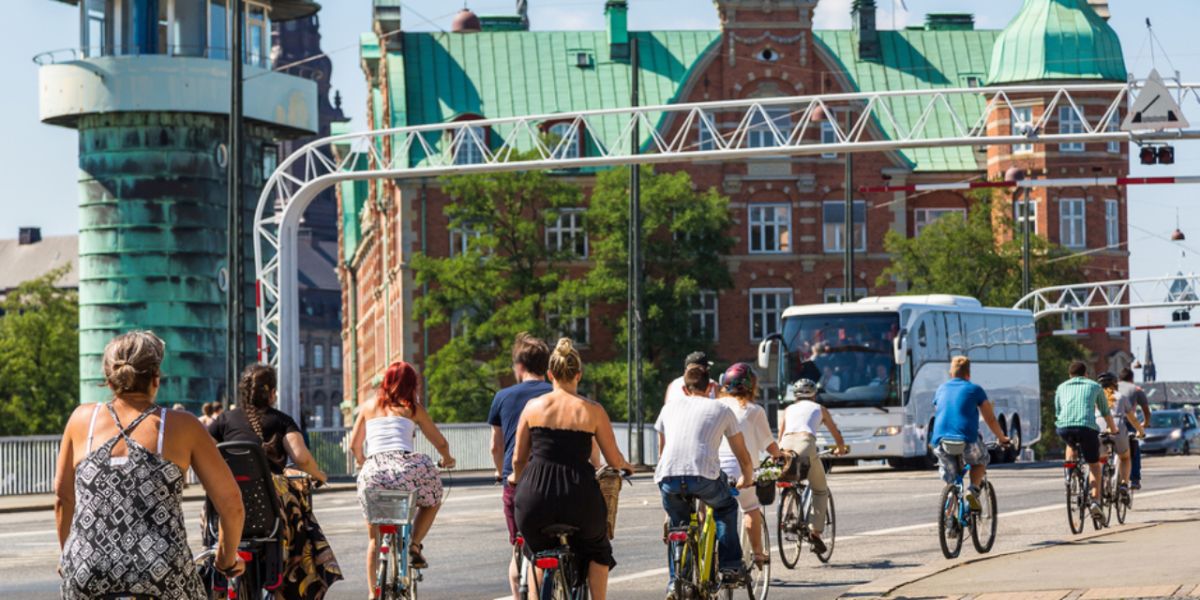
In Denmark's capital, there are plenty of ways to get around the city. There are well-developed bus, train, and taxi services. Also, there is an extensive bicycle route; you can cycle everywhere to stay environmentally friendly and discover the city in a unique way.
Good to know:
Rush hour in Copenhagen generally refers to 07:00-09:00 in the morning and 15:30-17:30 in the afternoon.
Bus services in Copenhagen
A- and S-buses
It is easy to take a bus anywhere in Copenhagen since there are numerous routes that crisscross the city at all hours. A-buses run at all hours and come most frequently: every 3-7 minutes in rush hour, and every 10 minutes outside of peak traffic times.
S-buses run from the city centre to outlying areas from 06:00 until 01:00. These buses run every 20 minutes, or 5-10 minute during rush hour. They make fewer stops than city buses and provide great connections to Copenhagen's suburban areas.
Bus route maps and schedules can be found in Danish at the DOT website.
Harbour buses
Copenhagen's harbour buses are actually boats or water buses. If you want a refreshing change from other modes of transport around the harbour area and feel like taking a cruise, try one of the harbour buses with route numbers 991 or 992. They use the same ticket system as regular buses and trains, so you don't need to worry about an extra expense!
S-tog (S-trains)
Copenhagen city trains are known as the S-trains. These trains serve the central and greater Copenhagen areas with lines A, B, Bx, C, E, F, and H. The trains run from early in the morning until just after midnight, depending on the route you are taking.
The DSB website will help you find the train schedules and ticket prices for your journey.
Metro in Copenhagen
The metro in Denmark's capital has two lines: M1 and M2. The system supplements the S-train network and provides a transport service that runs until after midnight on all days. In peak hours, trains come as often as every 2-4 minutes. More information about timetables, tickets, and future routes (in English) can be found on the Metro website.
Taxis in Copenhagen
Taking a taxi is by far the most expensive transport method in Copenhagen, although tips are at least included in the taxi fare. Taxis can be booked in advance at an additional cost; you can also find a taxi by hailing one on the street or waiting at a taxi stand. Both cash and credit cards are accepted for payment.
Cycling in Copenhagen
Copenhagen is a biking city. Getting around by bike is one of the easiest and most convenient transport methods ' you can even take your bike on the trains and buses (read more about the rules for this on the DOT website).
For expats who plan on biking regularly, it might be worth investing in your own bicycle. Alternatively, check out Copenhagen's bike-sharing program Bycyklen.
Airport transfers in Copenhagen
The transfer time between Copenhagen airport and the city centre is only 15 minutes. There are several transport options: the metro, train, bus, and taxi.
The metro runs the most frequently with trains every 4-6 minutes. The train and bus both run at 10-minute intervals, although the bus journey is a bit slower.
Tickets in Copenhagen
There are many different types of tickets available: from single-day passes to period tickets, tourist tickets, and discounted options for students, Copenhagen has made many options available to suit every need.
The Rejsekortet is a travel card used by commuters; as an expat, you will probably benefit from this type of ticket. The City Pass gives unlimited access to all transport types, including options between the city centre and airport.
The Copenhagen Card is perfect for visitors who will be staying up to four days. This card not only includes unlimited use of all transport types but also gives free admission to the most popular museums and attractions in the city.
Good to know :
Children under the age of 12 travel free when accompanied by an adult. See more information about discounts and rules for children on the DOT website.
If you have trouble using the vending machine to buy tickets, look for a tourist office or ask for assistance. It is better to have your tickets ready when using transport since tickets cannot always be bought on board.
We do our best to provide accurate and up to date information. However, if you have noticed any inaccuracies in this article, please let us know in the comments section below.








